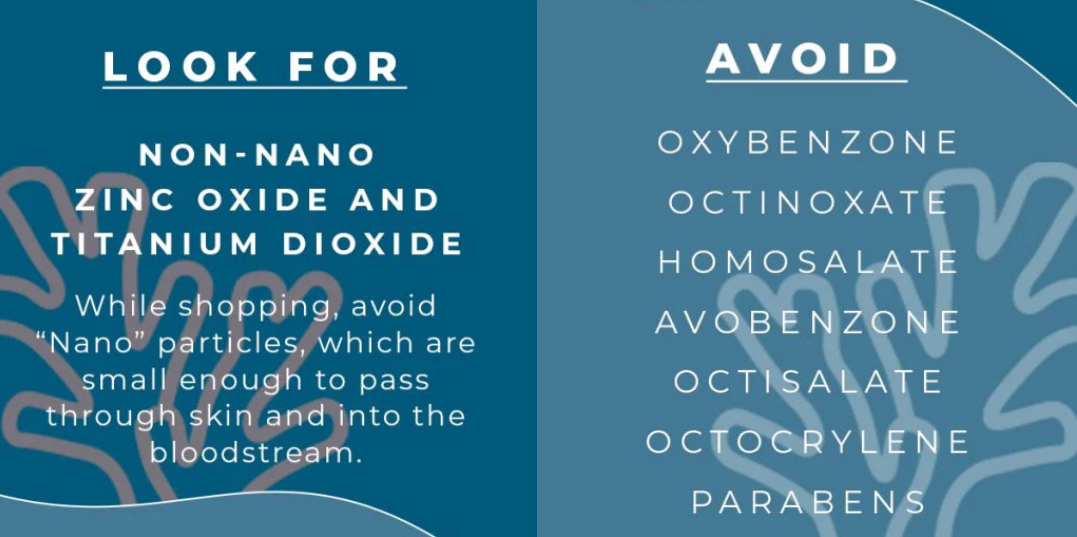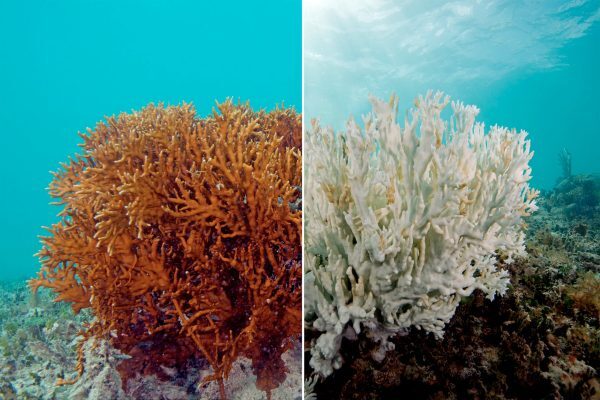What the Sunscreen?

Spring Break is here, which means Summer is around the corner! And if you reside in the Sunshine State, you probably know that it’s sunny season all year long (yes, you can even get sunburned when it’s cloudy out). And at the top of the Summer essentials list is sunscreen. No one has time for a sunburn! But as we dig into our Summer prepping, one thing we are asking ourselves is what exactly is in our sunscreen? You’ve probably heard of reef-safe versus traditional sunscreen, but what about chemical versus mineral-based? In this blog, we’ll dive into frequently asked questions around sunscreen and our changing planet.
Reef-safe sunscreen is making global headlines with articles banning chemical-based sunscreens, or closing coral reefs to rehabilitate them. But what really is reef-safe sunscreen, and why is it better for human health, and for the health of the planet? How is sunscreen linked to aquatic ecosystems, and why should you care?
Fact: all sunscreens must contain some sort of active ingredient – aka any ingredient that produces a chemical or biological impact – to protect against the sun’s rays effectively. But… not all active ingredients are the same.
Chemical vs Mineral-based Sunscreens
Traditional, or chemical, sunscreens work like a sponge by absorbing the UV rays and preventing them from entering your skin through a chemical reaction. They contain active ingredients like oxybenzone and octinoxate which have been shown to cause extensive damage to coral reefs. On the other hand, mineral sunscreens don't absorb into your skin but instead act as a barrier on the skin’s surface and reflect the sun's UV rays. Typical ingredients found in mineral sunscreens are titanium dioxide and zinc oxide.
Conventional sunscreens, or chemical sunscreens, rely on chemical filters as their active ingredient, and can contain a combo of oxybenzone, avobenzone, octisalate, octocrylene, homosalate or octinoxate to ‘protect’ your skin from the sun by absorbing UV rays through a chemical reaction.

But the truth is that these chemical filters are actually able to absorb into our skin – and are beginning to be linked to major health concerns, most prominently hormone disruption. The most recent study by the FDA in May 2024, raised major concerns about the lack of long-term testing for these ingredients that were originally approved in the 70s, and has begun to push for greater scientific research overall. But, even without these long-term studies, we already know a lot about these different chemical filters.
Let’s start with oxybenzone.
According to the EWG, oxybenzone is in nearly 65% of chemical sunscreens. Oxybenzone can also pass from expectant mothers to their children through their breast milk, and more research is being done to study the ongoing impacts of such exposure. Beyond just the human health impacts, oxybenzone is one of the leading causes of coral bleaching, a problem which has wiped out a sizable portion of our global coral reefs. They work by decreasing the natural ability of coral to defend themselves against bleaching, and damage their DNA and development. This damage pairs with other environmental stressors like ocean acidification, rising sea temperatures, and water pollution to limit the ability of coral to reproduce and survive as a whole.
What Is "Reef-Safe" Sunscreen?
A reef-safe sunscreen is a term used to refer to sunscreens that don't contain chemicals like oxybenzone that have been shown to cause coral bleaching. These reef-friendly sunscreens contain active ingredients like zinc oxide or titanium dioxide that act as a shield against UV rays and are able to biodegrade. A non-toxic and biodegradable sunscreen is truly what it means to be a 'reef-safe' sunscreen.

Reef-safe sunscreens, aka mineral-based sunscreens, are quickly becoming popular as a non-toxic alternative to chemical sunscreens that still protect you from the sun’s rays. They rely on active ingredients like titanium dioxide and zinc oxide, both of which provide ample UVA/UVB sun protection and are considered to be non-hazardous for both humans and coral reefs.
What Does SPF Mean?
You must be curious about what SPF stands for on your typical sunscreen. SPF stands for Sun Protection Factor which means the amount of protection the sunscreen will provide for your skin against UV (ultraviolet) rays. There are two types of rays that you need to watch out for when out in the sun, UVA, and UVB. UVA penetrates deep into the skin at the dermis layer which causes long-term skin damage. UVB rays reach the top layer of the skin, the epidermis layer, which is responsible for causing sunburns and skin cancer.
What about the babes?
Babies and kids have naturally sensitive skin, and can sunburn extremely easily, so they absolutely need to be wearing sunscreen and other sun protection items when they go outside. They’re also more prone to allergic reactions and adverse reactions, so it’s important that they are wearing a mineral-based, non-toxic sunscreen. Babies and kids have naturally sensitive skin, and can sunburn extremely easily, so they absolutely need to be wearing sunscreen and other sun protection items when they go outside. They’re also more prone to allergic reactions and adverse reactions, so it’s important that they are wearing a mineral-based, non-toxic sunscreen.
There is so much information out there and we hope this helped narrow down a few things. Most importantly, look for the ‘reef-safe’ label and read your ingredients! Cheers to tons of fun in the sun!
